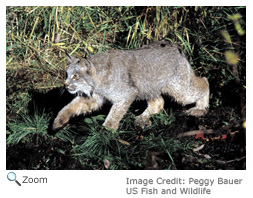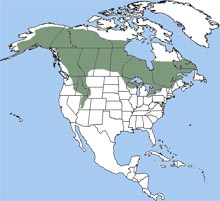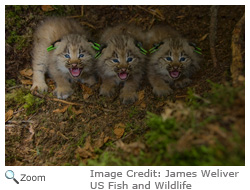Characteristics
 The Canada lynx has very thick, light brown or gray fur with light black spots. It has large ears with long black tufts at the ends. Its tail is short with a black tip at the end. It has a pointed, beard-like ruff and long legs with big paws. Its paws work like snowshoes and distribute the lynx's weight, helping it move in the snow. The Canada lynx has very thick, light brown or gray fur with light black spots. It has large ears with long black tufts at the ends. Its tail is short with a black tip at the end. It has a pointed, beard-like ruff and long legs with big paws. Its paws work like snowshoes and distribute the lynx's weight, helping it move in the snow.
Range
 The lynx's range extends over most of Canada and Alaska and south into parts of Washington, Oregon, Idaho, and Montana.
The Canada lynx is an endangered species in New Hampshire. A breeding population was present in the northern part of the state until the 1950s. Since then there have been some sightings of the lynx in the White Mountains.
In January of 2006, Canada lynx tracks were confirmed in Jefferson, New Hampshire on
U.S. Route 2. The lynx's range extends over most of Canada and Alaska and south into parts of Washington, Oregon, Idaho, and Montana.
The Canada lynx is an endangered species in New Hampshire. A breeding population was present in the northern part of the state until the 1950s. Since then there have been some sightings of the lynx in the White Mountains.
In January of 2006, Canada lynx tracks were confirmed in Jefferson, New Hampshire on
U.S. Route 2.
Habitat
Lynx live deep in coniferous forests near rocky areas, bogs and swamps.
Diet
About 75% of the lynx's diet is made up of the snowshoe hare. It also eats birds, meadow voles, carrion and sometimes larger animals like deer and caribou. Lynx often store leftover kill by covering it with snow. Adult lynx are solitary hunters, although a mother and her young will often hunt together. It usually hunts at night and stalks its prey before pouncing on it. The lynx can climb trees and it often waits on a branch for passing prey.
|
|
Life Cycle
 During mating season, the male will follow a female. Lynx mate between February and March. Two months after mating, the female will give birth to one to six kittens. The average litter has two to four kittens. The kittens have soft streaked and spotted fur. They are fully weaned at around three months but will start eating meat when they are as young as one month old. The kittens will stay with their mother for their first year. Once they leave their mother, the young lynxes may stay together for a short period of time. During mating season, the male will follow a female. Lynx mate between February and March. Two months after mating, the female will give birth to one to six kittens. The average litter has two to four kittens. The kittens have soft streaked and spotted fur. They are fully weaned at around three months but will start eating meat when they are as young as one month old. The kittens will stay with their mother for their first year. Once they leave their mother, the young lynxes may stay together for a short period of time.
Behavior
 Lynx are territorial and solitary. The homeranges of females may overlap and a male's and a female's range may overlap, but male's ranges are separate. Lynx are territorial and solitary. The homeranges of females may overlap and a male's and a female's range may overlap, but male's ranges are separate.
Video Credit: US Fish and Wildlife
|